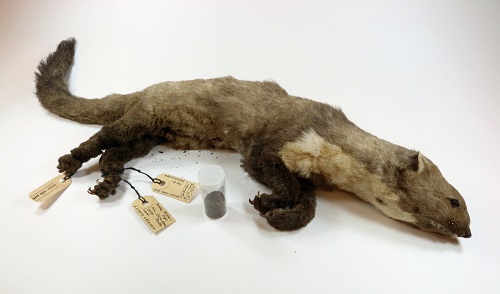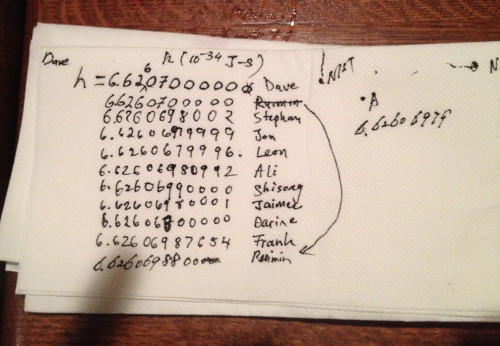By Michael Banks
From the law of defecation to CERN emojis, physics has had its fair share of quirky stories this year. Here is our pick of the 10 best, not in any particular order.
Marten on display

Stuffed. (Courtesy: Natural History Museum of Rotterdam)
You may remember the strange story last year of a marten that entered an electrical outbuilding at CERN and gnawed through a 66 kV transformer. The move ended up frying the weasel-like creature and triggering a wide power outage at the Large Hadron Collider (LHC). But when another marten met its doom in November 2016 by chewing on an 18 kV transformer, the animal was kept for posterity, rather than being disposed of like its chum. The 18 kV marten was stuffed and earlier this year went on display at the Rotterdam Natural History Museum’s Dead Animal Tales exhibition. “With a growing human population size and ongoing habitat destruction and urbanization, man and animal more often share the same environment. We have to be prepared for more collisions,” museum director Kees Moeliker told Physics World. “This tiny creature shutting down the LHC is, in a way, poetic, and as such deserves a place of honour in our exhibit.”
LEGO’s famous four
A LEGO set featuring minifigures of four women who played a crucial role in the history of the US space effort was finally released by the firm this year. It was created in July 2016 by US science writer Maia Weinstock and quickly gained in popularity on the LEGO Ideas website. The LEGO set consists of computer programmer Margaret Hamilton; astronaut Sally Ride; astronomer Nancy Grace Roman; and astronaut Mae Jemison, who in 1992 became the first African- American woman in space. “I’m extremely excited that the set was chosen, and very appreciative of the opportunity LEGO will be giving to children around the world to learn about these four women,” Weinstock told Physics World.
A gathering of minds
A world-record-breaking hoard of Albert Einsteins invaded Toronto in Canada at the end of March. Precisely 404 people, mostly school children, gathered in the city’s MaRS Discovery District dressed in the physicist’s quintessential blazer and tie, and sporting bushy white wigs and fluffy moustaches. Their effort smashed the existing Guinness World Record for the “largest gathering of people dressed as Albert Einstein” that had been set in 2015 by 304 students from Black Pine Circle School in Berkeley, US. The gathering also kicked off this year’s Next Einstein Competition, which invites the public to submit ideas that “can make the world a better place”, awarding the winner $10,000 to help them realize it. “We’re living in a world where people are not revealing their ideas,” says Rami Kleinmann, president of the Einstein Legacy Project.
Number-two study
Avid readers may remember the “law of urination” that was derived by David Hu and colleagues at Georgia Institute of Technology, US in 2014. By painstakingly analysing videos of animals urinating, they discovered that mammals ranging in size from a cat to an elephant each take around 21 s (give or take 13 s) to urinate. The researchers came back for more IgNobel-prize-worthy research with a study of the physics of animal defecation. By watching videos of various mammals doing their business at Atlanta Zoo, Hu’s team has found that they all take around 12 s to defecate despite the length of the rectum in the animals ranging from 4 cm (in cats) to 40 cm (in elephants). The team offers the explanation that despite larger animals having more faeces – elephants can produce a volume of 20 litres – they have a thicker layer of mucus in the large intestine than smaller mammals that aids ejection. While this number-two study focuses on cylindrical faeces, the team is now planning to work on pellet-like poo from rodents as well as cubical droppings from wombats. So any guess in which journal the research was published? Soft Matter, of course.
CERN goes iconic

(Courtesy: Esma Mobs/CERN)
There are more than 1800 emoji that can be sent and received in text messages and e-mails. This year, the CERN particle-physics lab near Geneva got in on the act and released its own collection of 35 images that can be used by anyone with an Apple device. Although most emoticons portray human emotions, activities or objects, CERN’s emoji include illustrations of collision events, a CERN hard hat, coffee cup, the lab’s Globe of Science and a Higgs collision event. “Our goal was to create an easily available way to showcase CERN activities, who we are and what we do here,” says Esma Mobs, who designed the emoji. CERN’s inclusion of an ambulance emoji seems an odd choice but Arnaud Marsollier, head of media relations at the lab, says it’s a nod to the “safety first” culture at CERN. He adds that the lab is planning to release more CERN emoji in the future. Watch this space.
Physics for babies
Think your baby is too young to learn about quantum entanglement or optical physics? Well, Chris Ferrie, a quantum physicist at the University of Technology, Sydney, doesn’t think so. He released two new board books earlier this year – Quantum Entanglement for Babies and Optical Physics for Babies – that you can add to your little one’s bedtime routine. For just £8 a pop, the tomes feature colourful drawings and a sentence on each page describing the illustrations. Examples include “All electrons have energy” with a basic picture of an atom and “This ball has mass” with an image of a ball. Published by Sourcebooks Jabberwocky, the new books follow on from four other titles – on quantum physics, Newtonian physics, general relativity and rocket science – that were published in May. While Ferrie says that publishing the books is a hobby and he is not looking for a career change, he is not resting on his laurels. Ferrie is releasing three more books in early 2018 on quantum information, statistical physics and electromagnetism.
Roll with it
With the holiday season now in full swing, we can think of nothing more frustrating than dashing for your plane at the airport with your suitcase in tow, only to find it rocking from side to side before finally overturning. Having had enough of these annoying oscillations, physicists from Paris Diderot University investigated the physics of the two-wheeled suitcase by putting a toy model of a suitcase on a treadmill. It turns out that the best way to deal with a wibbly-wobbly suitcase is not to slow down, but instead to either pivot the handle as close to the ground as possible or speed up. The researchers say that the same effect can be seen when a car tows a caravan. It strikes us, though, that you would need to be a brave driver to stop a rocking caravan by accelerating rather than slowing down.
Beware the birds
Researchers working on the Laser Interferometer Gravitational-Wave Observatory (LIGO) might be answering some of the biggest questions in astrophysics, but in August they had a rather more down-to-Earth problem to solve. When spurious glitches were picked up by the detector characterization group at the LIGO detector based in Hanford, Washington, they went on an investigation to find the culprit. The team suspected that ravens were to blame as they had been seen causing mischief on tubes that vent nitrogen gas. These pipes are connected to the vacuum enclosure and any vibration could change the optical path length of light that is scattered from the test mass and reflected back. Upon closer inspection, LIGO researchers found peck marks that were “consistent with the size of a raven’s beak”. Not content with just watching the birds at play, the team performed “simulated pecking” to see how this affected the machine’s performance. With the culprit now identified, you will be pleased to hear that the lines are set to be insulated to fend off the birds. “I guess we can’t blame [the ravens] for desiring ice on a hot desert afternoon,” writes Robert Schofield in a LIGO logbook post.
Tasting success

Predicting Planck’s constant. (Courtesy: NIST)
A paper napkin with a load of numbers scrawled on top was an unusual source of excitement for physicists at the US National Institute of Standards and Technology (NIST) in Gaithersburg, Maryland. One evening in December 2013, a group gathered at a local watering hole to celebrate the success of NIST’s latest watt balance – NIST-3 – that had just determined Planck’s constant to a new accuracy. While enjoying “happy hour”, NIST researcher Dave Newell pulled out a napkin and the 10 researchers began to write down their predictions for the final value of Planck’s constant that NIST would submit to the International Bureau of Weights and Measures in Paris to help redefine the kilogram. The researchers sealed the napkin in a plastic bottle and buried it inside a cavity within the foundation of NIST-3’s successor – NIST-4 – that was then being constructed. Fast forward four years and NIST-4 made an even more accurate measurement of Planck’s constant that is now being compared to values at other national labs. So whose prediction came closest? The winner was Shisong Li from China’s National Institute of Metrology who guessed 6.62606990000 × 10–34 Js against the submitted value of 6.626069934 × 10–34 Js. And what better way to celebrate than with a trip back to the local together with an “Italian rum cake”.
Free for all
The PhD thesis of the University of Cambridge physicist Stephen Hawking was made freely available to read by the university library’s Office of Scholarly Communication in late October. Hawking completed his PhD – entitled “Properties of expanding universes” – in 1966 when he was 24 years old. To mark Open Access Week 2017, the 117-page tome was posted on the university’s Apollo open-access repository, which is already home to some 15,000 research articles and 2400 theses. Within hours of Hawking’s opus being posted online, demand was so great that the site crashed. However, according to the university, it was still downloaded more than 60,000 times in the first 24 hours before access was restored. “By making my PhD thesis open access, I hope to inspire people around the world to look up at the stars and not down at their feet,” Hawking noted.
You can be sure that next year will throw up its fair share of quirky stories from the world of physics. See you in 2018!
Guidelines
Show/hide formatting guidelines
this text was deletedwhere people live in harmony with nature and animals</q>
Some text